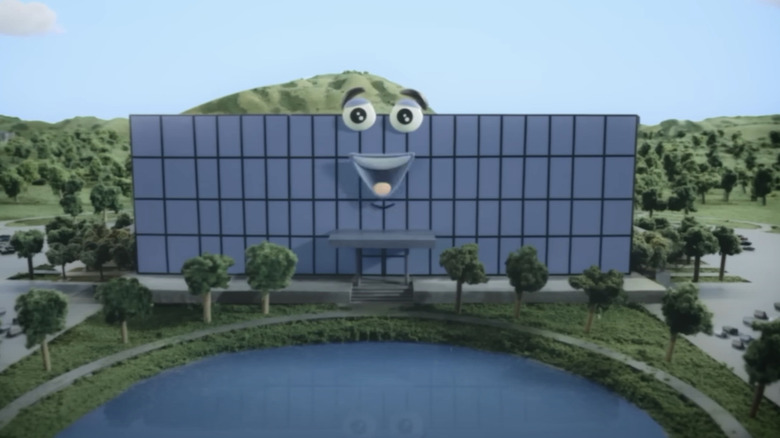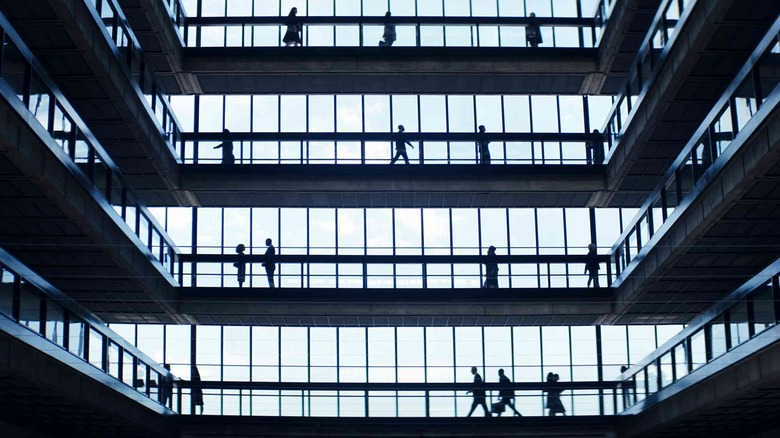Severance's Lumon Building Originally Had A Completely Different Look
The Lumon building at the center of Dan Erickson's dystopia sci-fi series "Severance" is actually Bell Works, formerly the Bell Labs Holmdel complex in Holmdel, New Jersey. The complex, designed by architect Eero Saarinen, was meant to be a worker-friendly space, replete with wide hallways and wide staircases, intended to be used for long, intense walk-and-talk co-working sessions as the employees moved from one lab to the next. The wideness, however, ended up being alienating, and Bell Labs employees complained that it took forever to walk around the building, and that the building looked sterile and unfriendly.
Of course, large, unfriendly, and sterile was perfect for a bleak TV series like "Severance," so the Holmdel complex was happily utilized. The building has been used by the city of Holmdel as a community center since 2006, and the building owner makes money on the side renting it out to film and TV productions. The building is currently owned by a man named Ralph Zucker, the CEO of a company called Inspired By Somerset Development. He paid $27 million for the building in 2013 and paid an additional $273 million for extensive renovations. Zucker said in an interview with "Make It" that he kept the building's original concrete exposed, making sure not to alter Saarinen's designs too much. It was a fortunate decision, as the starkness caught the eye of the "Severance" location scouts. "Stark and soulless" became the Lumon Industries aesthetic.
But it turns out that wasn't the way Erickson originally wrote the Lumon building when he was first conceiving of the series. In his mind, the Lumon building wasn't supposed to be anything special. He liked the idea of Lumon operating out of a completely dull, wholly nondescript office building, as one might see in the movie "Office Space." In an interview with Variety, "Severance" executive producer Ben Stiller noted that it was his idea to turn Lumon into something more retro-inspired.
Dan Erickson wanted Lumon to take place in a boring '90s office building
In the Variety article, it's explained that Erickson, a TV newbie at the time, was very thorough in his conception of "Severance." He and Ben Stiller put together sizable guidebooks, full of physical architecture and reference photos from other movies and TV shows. Stiller recalled Erickson's idea that Lumon operate out of, in his words, a "mundane '90s office building." Fans of "Severance" know that the Lumon building is not mundane, but threatening.
The basement office of the Lumon building, where much of "Severance" takes place, is an artificially constructed set, and it bears a 1960s- or perhaps 1980s-style retro aesthetic. The carpets are a shade of green that fell out of favor in 1968, and the computers are all large, plastic CRT boxes with chunky keyboards. There are no cell phones, no touchscreens, and no slim laptops. In a weird way, Lumon is timeless. Evidently, that retro-'60s/'80s timelessness was Stiller's contribution. If the world of "Severance" is replete with bizarro brain-severing technologies, then it makes sense for it to sport an eerie, sci-fi-looking innerspace.
Not that "Severance" wouldn't have functioned in an "Office Space" type of environment. Many mundane '90s office buildings feel just as severed from the outside world as the Lumon building. Also, if the building was more familiar to viewers, the weird, cult-like horrors and inexplicable goat-herding subplots of "Severance" would have just felt that much stranger and more nightmarish.
Of course, the work of production designer Jeremy Hindle has won awards and netted him an Emmy nomination, so Stiller's sci-fi approach was ultimately effective. Indeed, the eerie hallways were inspired a lot by Ridley Scott's "Alien" set from 1979. Erickson's original vision would have been interesting to see, though.

